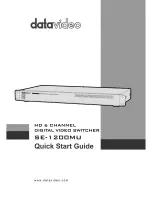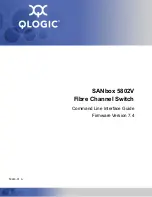
2
Operating instructions
Hinge safety switch
TVS 410
EN
1.6 Warning about misuse
In case of inadequate or improper use or manipulations of the
safety switchgear, personal hazards or damage to machin-
ery or plant components cannot be excluded. The relevant
requirements of the standard EN 1088 must be observed.
1.7 Exclusion of liability
We shall accept no liability for damages and malfunctions resulting from
defective mounting or failure to comply with this operating instructions
manual. The manufacturer shall accept no liability for damages result-
ing from the use of unauthorised spare parts or accessories.
For safety reasons, invasive work on the device as well as arbitrary re-
pairs, conversions and modifications to the device are strictly forbidden;
the manufacturer shall accept no liability for damages resulting from
such invasive work, arbitrary repairs, conversions and/or modifications
to the device.
2. Product description
2.1 Ordering code
This operating instructions manual applies to the following types:
TVS 410
➀
-11/11
➁
➂
No. Option
Description
➀
SK
Screw connection
CC
Cage clamps
ST1
M12 connector bottom
ST2
M12 connector top
➁
U
adjustable switching angle
I
preset for inside assembly
A
preset for outside assembly
➂
no assembly end stops
N
with assembly end stops
2.2 Special versions
For special versions, which are not listed in the order code below 2.1,
these specifications apply accordingly, provided that they correspond to
the standard version.
2.3 Destination and use
The TVS 410 hinge safety switch has been designed to prevent, in con-
junction with the control part of a machine, movable safety guards from
being opened before hazardous conditions have been eliminated. They
are also suitable for fitting on profile sections and existing equipment.
Hinge safety switches can only be used for applications, in
which the hazardous condition is terminated without delay
(e.g. run-on movements) when the safety guard is opened.
The user must evaluate and design the safety chain in accordance with
the relevant standards and depending on the required safety level.
2.4 Technical data
Standards:
IEC 60947-5-1; EN ISO 13849-1;
EN 1088; BG-GS-ET-15
Enclosure:
Zinc diecast, enclosure cover
self-extinguishing thermoplastic
Hinge bolt:
Stainless steel 1.4305
Contact material:
Silver, gold-plated
Protection class:
IP65
Contact type:
Change-over contact with double break Zb
Switching system:
A
IEC 60947-5-1; slow action,
NC contact with positive break
Connection:
Screw terminals, cage clamps, connector
Cable type:
solid wire
Cable section:
- Screw terminals:
min. 0.14 mm², max. 1.5 mm²
- Cage clamps:
min. 0.25 mm², max. 1 mm²
Cable type:
solid and stranded wire
Cable section:
- Screw terminals:
min. 0.25 mm², max. 1 mm²,
with conductor ferrules,
- Cage clamps:
min. 0.25 mm², max. 0.75 mm²
with conductor ferrules
Cable entry:
2 x M16
Positive break angle:
10°
Actuating speed:
max. 180°/0.3 s
Actuating frequency:
max. 1200 operations/h
Mechanical life:
> 1 million operations
Ambient temperature:
−25 °C … + 65 °C
Utilisation category:
AC-15, DC-13
I
e
/U
e
:
2 A / 230 VAC;
1 A / 24 VDC
U
i
:
250 V,
36 V only ...ST1 and …ST2
U
imp
:
2.5 kV,
0.8 kV only …ST1 and …ST2
I
the
:
2.5 A
U
e
max:
230 VAC (…ST1 and …ST2: 24 VAC),
24 VDC
Max. fuse rating:
2 A gG D-fuse
Switching of low voltages:
1 mA / 5 VDC
Mechanical data (see Fig.):
F1
5,000 N
F2
5,000 N
F3
1,900 N
F4
800 N
F1
F2
F4
F3
F1
F2
F3
F4
2.5 Safety classification
Standards:
EN ISO 13849-1
B
10d
(NC contact):
2.000.000
B
10d
(NO contact) at 10% ohmic contact load:
1.000.000
Service life:
20 years
MTTF
B
d x
x
h
s/h
3600
d
10d
op
op
op
n
0,1 x n
op
t
cycle
(Specifications can vary depending on the application-specific
parameters hop, dop and tcycle as well as the load.)
























